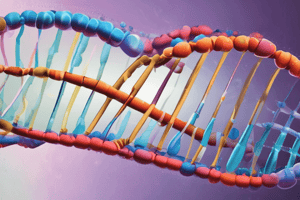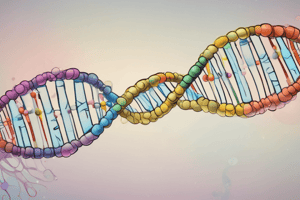Podcast
Questions and Answers
Which enzyme is responsible for unwinding the parental double helix during DNA replication?
Which enzyme is responsible for unwinding the parental double helix during DNA replication?
- DNA helicase (correct)
- DNA ligase
- RNA primase
- DNA polymerase
What is the role of single-strand binding proteins in DNA replication?
What is the role of single-strand binding proteins in DNA replication?
- They prevent the re-pairing of the separated DNA strands. (correct)
- They join Okazaki fragments together.
- They synthesize the RNA primer.
- They have no significant role during replication.
Which of the following statements about replication origins in eukaryotic cells is accurate?
Which of the following statements about replication origins in eukaryotic cells is accurate?
- Replication origins are random along the chromosome.
- Eukaryotic chromosomes have only one origin of replication.
- Replication origin sequences are identical across different eukaryotic species.
- Eukaryotic chromosomes can have hundreds to thousands of origins of replication. (correct)
What is formed from the processes of DNA replication at each end of a replication bubble?
What is formed from the processes of DNA replication at each end of a replication bubble?
During DNA replication, what is the significance of forming leading and lagging strands?
During DNA replication, what is the significance of forming leading and lagging strands?
Which enzyme is responsible for unwinding the parental double helix at replication forks?
Which enzyme is responsible for unwinding the parental double helix at replication forks?
What is the primary function of DNA polymerase III during DNA replication?
What is the primary function of DNA polymerase III during DNA replication?
What happens at the replication fork during DNA replication?
What happens at the replication fork during DNA replication?
In what region of eukaryotic cells does DNA replication primarily occur?
In what region of eukaryotic cells does DNA replication primarily occur?
What is the role of DNA polymerase I in the DNA replication process?
What is the role of DNA polymerase I in the DNA replication process?
Flashcards are hidden until you start studying
Study Notes
Mechanism of DNA Replication
- DNA replication initiates at origins of replication, specific nucleotide sequences in eukaryotic chromosomes.
- Eukaryotic chromosomes can contain hundreds to thousands of replication origins.
- Replication progresses bidirectionally from these origins until the entire DNA molecule is duplicated.
- Replication forks, Y-shaped regions, are formed at the ends of replication bubbles where parental DNA strands are unwound.
Steps of DNA Replication
-
Unwinding Double Helix:
- DNA helicase breaks hydrogen bonds, unwinding the double helix and separating parent strands.
- Single-strand binding proteins stabilize unpaired DNA strands to prevent re-pairing.
- Topoisomerase alleviates tension by breaking, twisting, and rejoining DNA strands ahead of the fork.
-
Synthesis of RNA Primer:
- Primase synthesizes RNA primers at the 5' ends of both leading and lagging strands by adding complementary RNA nucleotides.
-
Assembling Complementary Strands:
- DNA polymerase III adds DNA nucleotides to the 3' end of the RNA primer to synthesize the new DNA strand.
- This synthesis occurs in the 5' to 3' direction, ensuring the new strand complements the template DNA.
-
Leading and Lagging Strands Formation:
- Due to the antiparallel nature of DNA, DNA polymerase can only add nucleotides to the 3' end, resulting in one continuous leading strand and a discontinuous lagging strand formed in Okazaki fragments.
-
Removing RNA Primer:
- DNA polymerase I removes RNA nucleotides from primers and replaces them with DNA nucleotides, adding to the 3’ end of adjacent fragments.
-
Joining Okazaki Fragments:
- DNA ligase joins sugar-phosphate backbones of Okazaki fragments to create a continuous DNA strand.
Enzymes and Proteins Involved
- DNA Helicase: Unwinds the double helix at replication forks.
- Single-Strand Binding Proteins: Prevent re-pairing of separated strands.
- Topoisomerase: Relieves strain ahead of the replication fork by modifying DNA structure.
- Primase: Synthesizes RNA primers necessary for DNA synthesis.
- DNA Polymerase III: Main enzyme for synthesizing new DNA strands, utilizing parental DNA as a template.
- DNA Polymerase I: Replaces RNA primers with DNA nucleotides.
- DNA Ligase: Seals gaps between Okazaki fragments to form a continuous strand.
Location of DNA Replication
- In eukaryotic cells, DNA replication occurs within the nucleus, facilitating access to the genetic material.
Studying That Suits You
Use AI to generate personalized quizzes and flashcards to suit your learning preferences.




